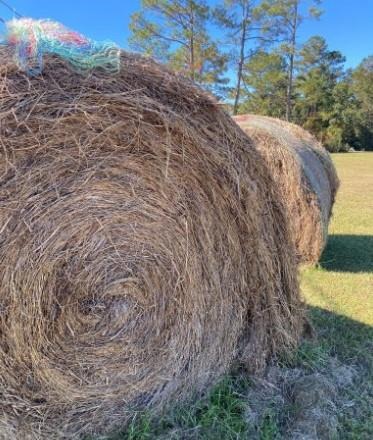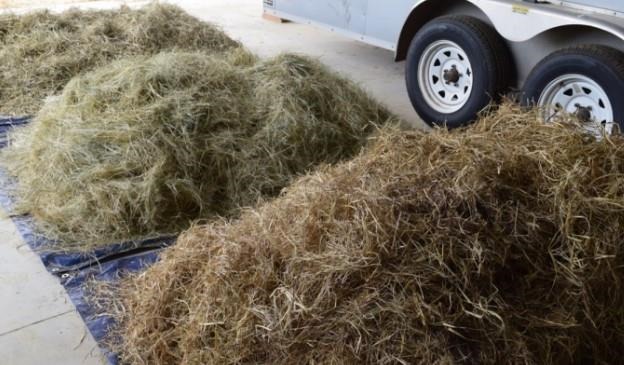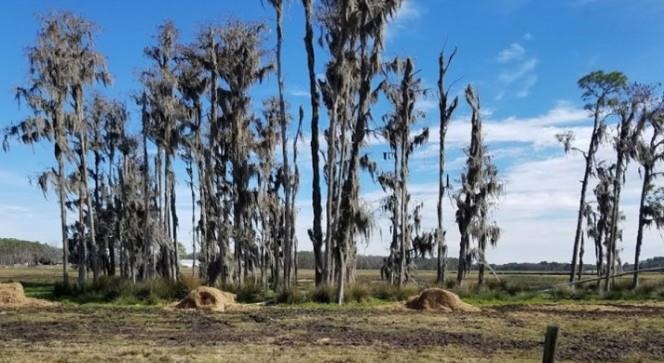By Robbie Jones and Marcello Wallau
Late fall is the time of year when farmers and ranchers begin to rely on hay as the main source of forage, either for the duration of winter, or at least as a bridge between warm season forages and cool season forages for grazing. The months of October through January can be a breeze if you have had the right growing season and abundance of extra forages to bale. However, that can change quickly if you were unable to put up enough hay and must rely on sourcing the forage from other locations. In years like 2021, when wet conditions throughout the summer prevented regular cuttings, good hay may be in short supply, and quality hay even harder to find. Some producers may be left with the option of purchasing bales of hay to get them through the rest of fall and into winter. When the time comes, any hay is ok… or is it?

Low quality previous year hay. Credit: Robbie Jones UF/IFAS
Hay can be a cheap insurance to get your herd through the fall and early winter forage gap, but it can quickly become an expensive option. High quality forage can provide a good source of crude protein and total digestible nutrients. With high quality forage, a farmer or rancher minimizes their need for nutrition supplements during this gap period. However, when you skimp on hay quality to save a few dollars, you can significantly increase the need for supplemental purchased feed to provide adequate nutrition. Instead of supplementing hay with feed, you may find yourself needing to spend more on feed than hay. What is often more common though, is that the same amount of feed supplements are offered with low quality hay and the cows suffer and lose weight dropping milk production and shutting down reproduction. The cows might be able to “tough it out,” but they won’t get bred on time or remain open.
 The amount of dry matter needed to reach equal nutritional value, with Tifton 85 in the back pile, Tifton 44 in the center, and low quality coastal bermudagrass cut from an over-mature field and stored outside in the front. Credit: Lisa Baxter, UGA Extension
The amount of dry matter needed to reach equal nutritional value, with Tifton 85 in the back pile, Tifton 44 in the center, and low quality coastal bermudagrass cut from an over-mature field and stored outside in the front. Credit: Lisa Baxter, UGA Extension
Ruminant digestive systems can also only hold so much food material. Higher quality hay requires less total dry matter to provide the same level of nutrition as low quality hay. For example, a producer feeding correctly timed and baled quality Tifton 85 bermudagrass hay would have to feed less hay than a producer feeding overly mature bahiagrass hay. When the hay quality drops, the required dry matter to meet the nutritional needs increases. This ends up being a battle of required forages versus space availability in the digestive tract. If cattle cannot eat enough of the forage to meet their nutritional needs, then there is a reduction of nutrient intake and body condition begins to decline.
Poor quality hay is also not appetizing for cattle. Cattle will try their best to cast aside the less desirable hay to get to the more appealing hay they want. A bale of poor-quality hay, that cattle want to pick through, can end up wasting 30-50 percent of the forage dry matter in a round bale. As a rule of thumb, a 6-ft round bale of hay can lose 25 % of its dry matter if the top 4 inches are lost, at 6 inches of depth the bale loses 33 % of total dry matter, and at 12 inches of depth the bale waste reaches 50 % of the dry matter. Having a poor quality bale that cattle want to eat only the inner three feet of the bale and cast aside the rest, can result in significant waste and money loss. Feeding “cheap hay” that loses 50 percent or more value from waste means you need double the number bales to compensate for the waste. It is not just the variety or age of the bale that can affect the quality of the hay. The maturity level at the time of baling can greatly affect overall quality. Also, the quality of the baler being used to roll a good tight bale, along with good storage can determine the quality of the hay. Forage that is high quality when cut, but improperly baled and stored out in the weather will leach out nutrients and can become low quality quickly.

Lower quality hay just placed in the field that cattle selectively ate and wasted a large portion of. Credit: Marcelo Wallau, UF/IFAS
When you put pen to paper and budget out the cost of hay, you can quickly see these variables can result is higher cost of feeding. How much is that hay really costing you? To understand that we created a quick calculation table for you, and you can plug in (or write down) your own numbers. First, it is essential to know the quality of you hay. Then we calculate what is missing based on our target requirements for each animal. Normally, our supplementation decisions are based on protein (crude protein or CP) and energy (total digestible nutrients or TDN). Based on the most limiting factor, then we calculate the supplementation needs to match requirements. Last, we need to calculate the price of supplement based on how much we need to feed and add to the cost of hay. It is important to consider hay losses in the calculation, which are normally greater for poor quality hay as compared to good quality hay. When hay is poorer quality, you will have to provide much more supplementation than you would with higher quality hay. For those more computer-savvy, the UF Hay Balancer created by Dr. Nicolas DiLorenzo is a great resource to go over those calculations.

Analysis of quality levels from 800 pound bales and the cost to feed these when taking into account costs for supplementation. Credit: Marcelo Wallau, UF/IFAS
If you are unsure how good that hay is you are feeding, then it’s recommended that you get a forage analysis performed on your hay. This can be done by working with your local UF/IFAS Extension Office. It is always recommended, no matter how good you think your hay is, to you have the hay tested yearly to see just how good it is. Any person buying supplements will always ask what are the TDN and CP levels, but when is the last time we asked how good that bale of hay truly is with the feed data you get from supplements?
In the end that famously marketed “cow hay” can wind up costing you much more in input costs, due to the supplementation needed to meet the nutritional demands of the herd, reduced intake of nutrients, more waste, and lost revenue from reduced weaning weights, weight gain, and open cows.
Source : ufl.edu